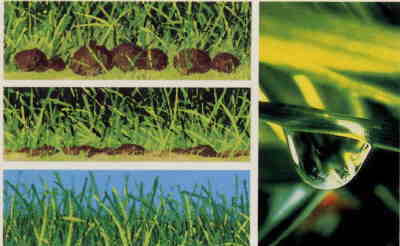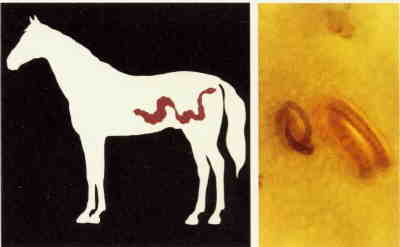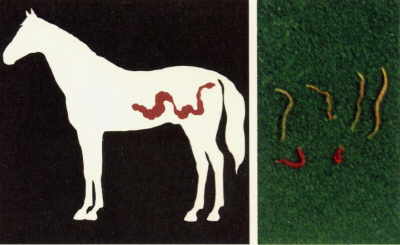Small Strongyles, the Small Blood Worm in Horses
by Robert N. Oglesby DVM
Introduction
Introduction
»
Small Strongyle Life Cycle
»
Description
»
Location
»
Diagnostic Information
»
Significance
»
Effect on Host
»
Deworming Programs
»
More Info & Discussions
Small strongyles is a growing problem in horses. Rapidly developing resistance to commonly used dewormers is leading to horses that, even though they are being dewormed regularly, are developing disease from small strongyles. Most serious is cyathostominosis, a disease caused by the rapid emergence of many small strongyle larva that results in weight loss, diarrhea, and death. Despite a feeling among horseowners that parasites are no longer much of a problem there is a growing world-wide recognition of this problem. This article deals with the life cycle of strongyles, diagnosis, and links to other articles on cyathostominosis, treatment, and prevention of this problem.
Small Strongyle Life Cycle
Introduction
»
Small Strongyle Life Cycle
»
Description
»
Location
»
Diagnostic Information
»
Significance
»
Effect on Host
»
Deworming Programs
»
More Info & Discussions
Small Strongyle Life Cycle
I would like to thank MSD-AgVet and Merck, makers of Eqvalan, for use of these photos.
|

Eggs, produced by adult females in the horse, are deposited on the pasture in feces. Larvae hatch and go through two molts to become third-stage larvae (L3). L3 larvae attach themselves to grass and are eaten by the horse. The rate that the larvae develop is greatly influenced by the environment. Development to the infective stage occurred only between 50 degrees F and 95 F (10 C - 35 C), taking 15-24 days and three days, respectively, at the lowest and highest temperatures for the developing stages to reach the infective third stage. Yields of infective larvae were very low outside the range 68 F - 91 F (20 - 33 C), and were highest at 82 F (28 C). Survival of infective larvae was good between 68 F and 91 F (20-33 C), and large numbers were recovered after three months in faeces incubated at 50 - 86 F (20-28 C).
|

L3 burrow into gut wall and complete development into L4 larvae. During this stage the larvae may develop an arrested development called hypobiosis. In this stage the larvae are resistant to most dewormers and may persist in the bowel wall for many months, possibly years.
|

Adults emerge into the large intestine where they feed and lay eggs.
|

Eggs are passed in the feces and deposited on pasture to continue life cycle.
|
Description
Introduction
»
Small Strongyle Life Cycle
»
Description
»
Location
»
Diagnostic Information
»
Significance
»
Effect on Host
»
Deworming Programs
»
More Info & Discussions
[wcm_restrict]
Small red to dark-brown worms ranging in size from 1/8 inch to 1 inch (3 mm to 25 mm).
Location
Introduction
»
Small Strongyle Life Cycle
»
Description
»
Location
»
Diagnostic Information
»
Significance
»
Effect on Host
»
Deworming Programs
»
More Info & Discussions
Small strongyles are present in the large intestine and surrounding tissue.
Diagnostic Information
Introduction
»
Small Strongyle Life Cycle
»
Description
»
Location
»
Diagnostic Information
»
Significance
»
Effect on Host
»
Deworming Programs
»
More Info & Discussions
Strongyle eggs passed in feces of foals less than six months of age may be assumed to be from small strongyles. Species identification on the basis of egg morphology is not possible. Larval differentiation can be done by fecal cultures or other specialized procedures.
Significance
Introduction
»
Small Strongyle Life Cycle
»
Description
»
Location
»
Diagnostic Information
»
Significance
»
Effect on Host
»
Deworming Programs
»
More Info & Discussions
Small strongyles are a frequent cause of illness and severe disease, especially since they normally occur in conjunction with another parasite. These worms may become more significant because several species have shown resistance to some benzimidazoles.
Effect on Host
Introduction
»
Small Strongyle Life Cycle
»
Description
»
Location
»
Diagnostic Information
»
Significance
»
Effect on Host
»
Deworming Programs
»
More Info & Discussions
Small strongyle adults are plug feeders, ingesting pieces of intestinal mucosa and blood vessels. Their mouths are smaller than those of large strongyles, making shallower bites, with less damage to underlying tissue. The clinical syndrome is usually related to the sudden release of large numbers of the larval stages of small strongyles from the mucosa of the large intestineand is called cyathostominosis. Typical clinical signs include diarrhea, ventral abdominal edema, fever, colic, weight loss, and poor body condition. Hypoalbuminemia and the presence of large numbers of small strongyles being passed in the feces are also characteristic features of the disease. The disease may occur seasonally in late winter and early spring or after drug treatment to remove the luminal stages of small strongyles,
...more.
Deworming Programs
Introduction
»
Small Strongyle Life Cycle
»
Description
»
Location
»
Diagnostic Information
»
Significance
»
Effect on Host
»
Deworming Programs
»
More Info & Discussions
For More Information on this Topic:
Introduction
»
Small Strongyle Life Cycle
»
Description
»
Location
»
Diagnostic Information
»
Significance
»
Effect on Host
»
Deworming Programs
»
More Info & Discussions
Search the National Library of Medicine for all the summaries on this topic. Just push the button the search fields have been already filled in:
[/wcm_restrict][wcm_nonmember] [text-blocks id="article-ender-join"][/wcm_nonmember]



